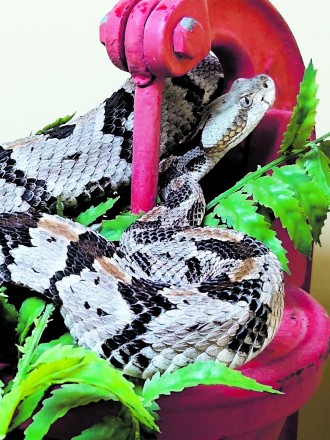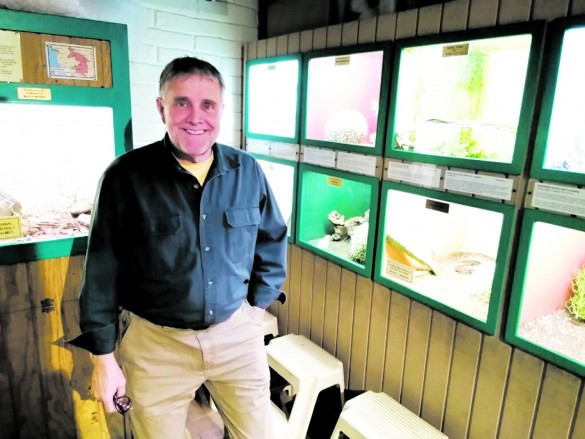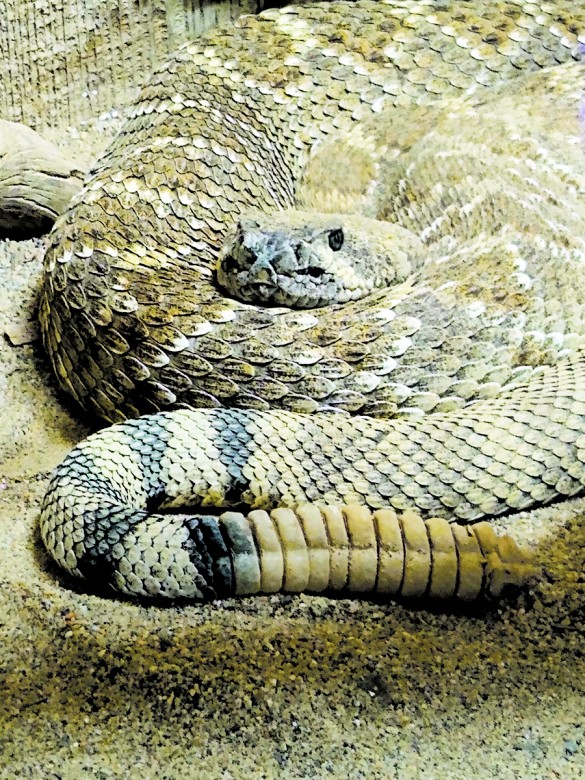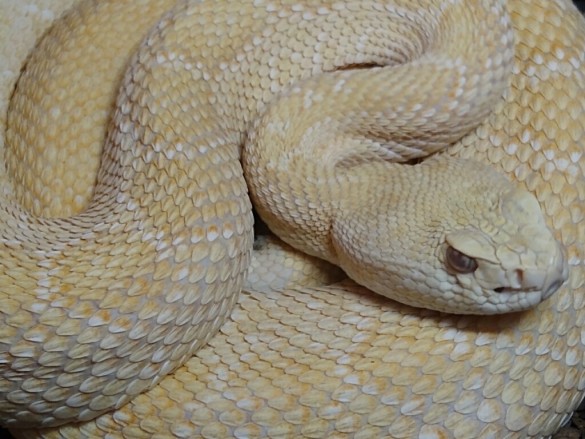Rattlesnake Museum
Old Town Museum Exhibits Live Snakes and Other Creepy Crawly Creatures
Rattlesnake Museum
December 12, 2022By GWYNNE ANN UNRUH

If you’re looking for something exciting and different to take your kids to, look no further. The American International Rattlesnake Museum in Albuquerque’s Old Town is the place to go. The museum is devoted to snakes and hosts one of the largest collections of live rattlesnakes in the world.
With 34 varieties of rattlesnakes behind glass in re-created habitats, the museum is dedicated to educating the public through the displays as well as an extensive library. The museum aims to correct common reptilian misconceptions. If your kids are lucky, there may be an opportunity to hold a python -- if they are brave enough.
Founder Bob Meyers, a biologist, started the museum 32 years ago. He said he has been interested in reptiles since he was 4 years old. “I was already bringing creepy crawlies home, from snails to snakes,” Meyers said. “All my life I had that interest.” Meyers majored in biology in college and went on to become a high school biology teacher in Florida.
“We always had a lot of reptiles in the classroom, even when I was teaching,” Meyers said. “I think I inspired a lot of kids to do the same thing in their lives.” After six years of teaching, Meyers returned to New Mexico, where he grew up, and thought about working in a museum. That led to thinking perhaps he could start his own museum -- and decided to jump in.
“It was pretty scary for me and that had nothing to do with rattlesnakes,” Meyers said. “It was scary because I had no business background.” He thought Old Town would be an ideal place for his endeavor. “It has been ideal,” he said. “We get a lot of visitors from around the world and over the last 32 years, the museum has become really well-known. The internet also has helped tremendously.”
In the beginning, Meyers contacted zoos around the country to obtain some of his specimens. “I gathered a few of my buddies together in the garage and somehow conned my friends into helping me set up an assembly-line style way to build the enclosures for the snakes that we're still using to this day,” he said.

When Meyers applied for a business license, officials went door to door to the other Old Town merchants. “Here’s this guy and he’s moving in with a load of live rattlesnakes and for some reason, they all said, “Oh sure, that's fine,” Meyers said. “And it turns out, having the Rattlesnake Museum in Old Town was good for my neighbors. A lot of people pass into their stores from my museum.” The museum has more than 50,000 visitors a year.
Initially, Meyers got his reptiles from zoos and private breeders. Now he continues to get snakes from zoos when they don’t fit the facility’s collection, from universities with research or donated snakes.
The live collection comprises about half the museum. The rest is artwork, artifacts, collectibles and a gift shop.
Meyers said the museum has the only complete collection of reptilian-related Kachina dolls -- about 32 total -- noting that the Smithsonian only has four.
“We've got a large collection of antique snake oil bottles going back to the mid-1800s,” Meyers said. “The snake oil was usually primarily alcohol. We also have snake oil products from Asia that include oil from the tissues of snakes as well as soaps and other products made in Mexico that have snake oil in them that are intended to be used on various skin problems.”
They have a collection of Steve Irwin, The Crocodile Hunter, memorabilia and an original John Audubon watercolor. “It's the only rattlesnake he ever did in conjunction with birds in the same painting,” Meyers said. “We also have a Remington bronze of a cowboy on horseback rearing up at the sight of a rattlesnake.”
The museum even has a venomous Gila monster and a variety of scorpions.

“We're hoping to get into a bigger facility sometime in the near future,” Meyers said. “Our collection of art and artifacts is so large that we only have one percent of it on exhibit at any one time.” Meyers said he has had offers from Colorado, Arizona and Arkansas but he turned them down because he’d like to see the museum stay in Albuquerque.
“There are a lot of options, at least in my mind, for logical spaces here in Albuquerque, including with the zoo,” he said. “I know for a fact I'm not going to live forever, but I'd sure like to know that the Rattlesnake Museum will.”
Myths about Snakes and Tips to Stay Safe
By DEBORAH BEGEL
Movies like “Snakes on a Plane” and the “Anaconda” series have given snakes a bad rap. In fact, the Rattlesnake Museum’s Bob Meyers says snakes aren’t aggressive at all; they only bite when they feel threatened.
Meyers has spent his life trying to educate people about the good they do. “Snakes are important predators that control rodent populations,” he says, because “rodents eat a lot of crops that are supposed to be human food.” He adds that rodents carry diseases like Hantavirus, which can kill humans, but snakes do not.
Another myth Myers dispels is the level of danger posed by a snake bite. “The death rate for humans is about one in a thousand,” he notes, “so if you’re bitten, don’t panic, but do seek medical attention.”
Even more surprising: “One quarter to one third of all bites are dry bites,” meaning there’s no venom in them.
What then, can kids and adults do to avoid getting bitten?

To start, don’t leave food for your dog in the back yard, because rodents will come and eat it. And snakes, Meyers points out, have an incredible sense of smell, so they can track down rodents from a distance.
In dry times, snakes might stop by for a drink of water. Or you might spot one on the trail. Nonetheless, Meyers said there’s no need to kill one.
“I recommend people go around it or take time to be with the snake,” he says. “Take some photos and enjoy the experience.”
You might pay attention to the time of day as well. In the summer, snakes tend to be active early in the morning and again in the evening and at night. Therefore, since many hikers prefer to hike during the hotter daytime hours, there are fewer encounters then.
More than anything, Meyers wants you to use common sense. “Most adults watch where they step,” so they’re unlikely to step on a snake. Kids are not as vigilant however, so he recommends that parents watch them closely.
“It’s a misconception that snakes are evil and out to get us,” he says. “That’s just not the case.”




